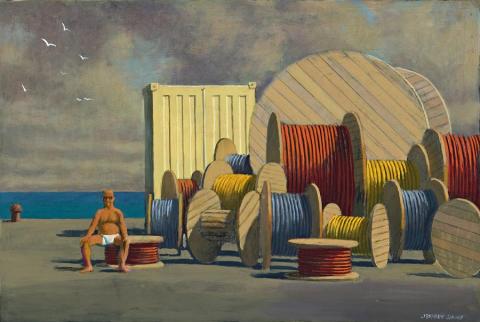FIRST STUDY FOR ON THE WHARF, LIVORNO, 2001
Jeffrey Smart
oil on paper on canvas
37.5 x 55.5 cm
signed lower right: JEFFREY SMART
Philip Bacon Galleries, Brisbane
Art Galleries Schubert, Queensland (label attached verso)
Private collection, Melbourne
Jeffrey Smart: Recent Paintings, Philip Bacon Galleries, Brisbane, 4 September – 6 October 2001, cat. 6 (illus.)
Jeffrey Smart, Drawings and Studies 1942–2001, Australian Galleries, Melbourne, 2001, featuring a photograph of the artist in his studio with On the Wharf, Livorno, 2001 and this study, p. 201 (illus.)
Study I 1989 for 'On the Wharf, Livorno', 2001, ink and watercolour on paper, 17.5 x 23.0 cm; Study II 1989 for' On the Wharf, Livorno', 2001, ink and watercolour on paper, 17.5 x 23.0 cm. Both illustrated in colour in Jeffrey Smart Drawings and Studies 1942–2001, Australian Galleries, Melbourne 2001, p. 142, cat. 168 and 169
Second study for' On the Wharf, Livorno', 2001, oil on canvas, 43.0 x 65.5 cm Study of Seagull for 'On the Wharf, Livorno', 2001, oil on canvas, 26.0 x 30.0 cm
Figure study for' On the Wharf, Livorno', 2001, oil on canvas, 40.5 x 34.0 cm
On the Wharf, Livorno, 2001, oil on canvas, 80.0 x 125.0 cm
Livorno, bustling port city of Tuscany, lies on the west coast of Italy, not far from Pisa. It is within easy driving distance from Jeffrey Smart's home near Arezzo. Established by the Medici in the sixteenth century, it is nowadays Italy's second busiest container port. The detritus of such a place was a magnet for Smart's brush. It provided the still life of living, which so fascinates the artist. Although stated with the utmost clarity and realism, it is rich in ambiguity and surreal references. His is the art of the enigmatic and immaculate finish. Who is the man seated in white shorts? Why does he stare at us? Do the cables make some esoteric reference to modern means of communication? And so on. Smart's answer has invariably been that it is all to do with composition; the perfect balance of form and engaging colour. But why the darkening sky? And why do the birds rise in flight? - to return to other questions unanswered. One important answer - it is a beautifully abstract work of art in which the artist has presented all in geometric terms. There are circles, ellipses, ovals and rectangles. This reliance on the fundamental continues into the use of primary colours of red, blue and yellow. In First Study for' The Wharf, Livorno' you come about as close as you can to the artist's act of creation. And, with Smart, there is invariably a bit of tongue in cheek. The horizon neatly balances on the man's bald head. And what of the bald bollard nearby, as lively as the shadows, which, in silence, snake across the wharf? Paradoxes abound, including profundity couched in seeming simplicity. The painting is so exact. Its narrative, like Samuel Beckett, waiting for Godot. The play on absence extends even to the unpresent ship.
The Livorno wharf paintings had an early genesis, the ink and watercolour studies being done during a three-day visit in 1989. 'For eleven years', Smart noted, 'these studies were in the studio before they were resolved into a composition which was completed in 2001.'1 In his journey to compositional perfection, he retained, in our oil painting, the basic layout of the ink sketches, developing it through another oil study before reaching the final version. Forms and colours were refined, and changes of detail introduced. The introduction of the middle-aged figure was Smart's solution to viewers reading other ideas into that of a 'pretty girl'.2 But nothing in a Smart painting can be dismissed as a mere object. And one is reminded of Smart's reference to 'the glorious human body', which he believed every artist must learn to draw to be a real artist.3
1. Jeffrey Smart Drawings and Studies 1942-2001, op. cit., p. 142
2. ibid.
3. Smart, J., 'On Drawing', Jeffrey Smart Exhibition of Drawings, Watercolours & Studies, Philip Bacon Galleries, Brisbane, 2003, no pagination
DAVID THOMAS
